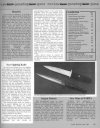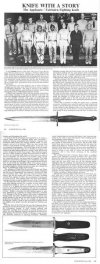I thought I'd post what I know about the couple of Applegate-Fairbairn knives I have. It's nothing new really, but maybe interesting for fans of the A-F, or anyone interested in how the brits looked at the knife when it first came out.
Its easy to think that the Fairbairn-Sykes gets all the attention in the UK, but although the Commando Knife deserves its iconic tag the Applegate-Fairbairn is well known over here, even if its sometimes mentioned as a final chapter in the F-S story. Theres an acceptance that its a better knife than the original, and probably the ideal double edge knife for the kind of styles that Applegate and Fairbairn favoured. Theres probably a bit of UK bias in how much of the design is attributed to the two men, and Sheldon Wickershams article on the A-F (http://blackjack.0catch.com/pages/wickershamafarticle.htm) has a different angle on how the A-F came to be, but then the knife is pretty clearly based on the F-S to some degree so it either way its fair for Fairbairn to have his name on the blade.
I first came across the A-F as a teenager when it was first released for sale. Back then I used to help my dad, Colin Greenwood, in the editorial office of a british shooting magazine called Guns Review. He often featured knives as well, and had a few reasons to be interested in the A-F. He knew of Col. Applegate (as well as W E Fairbairn) from his time working on armed tactics for the British Police - apart from his own books on the subject he has a chapter in W Cassidys book Quick or Dead alongside the likes of Rex Applegate and Bill Jordan. He also visited the US often in the 70s and 80s as a vocal advocate of shooters rights, speaking for the NRA and others on the subject (another area where he published a book, Firearms Control, although it could have been subtitled and why it doesnt reduce armed crime). I know he met Rex Applegate more than once on those visits, and Ive got copies of a few of Applegates books signed to Colin Greenwood.
When the first Yancey Applegate-Fairbairn knives came out he was keen to get hold of one and to promote it. He wrote a small piece on the knife on its release, and I can remember being shown the knife and told all about it when it first turned up, but for some reason it was nearly a year later when he added a more in depth feature. Things moved a bit more slowly in the publishing world then I think.
Ive scanned copies of the original pieces on the Yancey A-F, plus the original UK advert which appeared in the issue before the write up for some reason (probably the piece being held over for a month), and Google Docs has done a pretty good job of converting it to text, so Ill try and post both.
The knife I have is the one that was reviewed, Yancey A-F #26. I dont know when exactly the white handled knives were made, so I probably cant quite claim its the 26th production A-F ever made, the best I could do would 26th production non-presentation A-F
When the Al Mar AF came out a few years later he was quick to get hold of an early green handled copy to review. Maybe this was a very early one, because the scales didnt really fit properly and there was some excess glue on them - I dont have a photo of it as it originally was as Ive rubbed down the inside of the scales to fit better since - the problem was really just excess glue from the handle weights. Not good on a review knife, and maybe that plus the shiny blade was one reason the write up on the release of the Al Mar seems to talk about the original Yancey more than the new version.
Heres a few pics of the knives as they are now, 35 and nearly 30 years on:
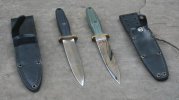
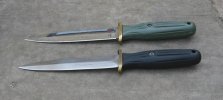
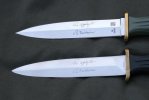
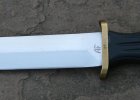
Its easy to think that the Fairbairn-Sykes gets all the attention in the UK, but although the Commando Knife deserves its iconic tag the Applegate-Fairbairn is well known over here, even if its sometimes mentioned as a final chapter in the F-S story. Theres an acceptance that its a better knife than the original, and probably the ideal double edge knife for the kind of styles that Applegate and Fairbairn favoured. Theres probably a bit of UK bias in how much of the design is attributed to the two men, and Sheldon Wickershams article on the A-F (http://blackjack.0catch.com/pages/wickershamafarticle.htm) has a different angle on how the A-F came to be, but then the knife is pretty clearly based on the F-S to some degree so it either way its fair for Fairbairn to have his name on the blade.
I first came across the A-F as a teenager when it was first released for sale. Back then I used to help my dad, Colin Greenwood, in the editorial office of a british shooting magazine called Guns Review. He often featured knives as well, and had a few reasons to be interested in the A-F. He knew of Col. Applegate (as well as W E Fairbairn) from his time working on armed tactics for the British Police - apart from his own books on the subject he has a chapter in W Cassidys book Quick or Dead alongside the likes of Rex Applegate and Bill Jordan. He also visited the US often in the 70s and 80s as a vocal advocate of shooters rights, speaking for the NRA and others on the subject (another area where he published a book, Firearms Control, although it could have been subtitled and why it doesnt reduce armed crime). I know he met Rex Applegate more than once on those visits, and Ive got copies of a few of Applegates books signed to Colin Greenwood.
When the first Yancey Applegate-Fairbairn knives came out he was keen to get hold of one and to promote it. He wrote a small piece on the knife on its release, and I can remember being shown the knife and told all about it when it first turned up, but for some reason it was nearly a year later when he added a more in depth feature. Things moved a bit more slowly in the publishing world then I think.
Ive scanned copies of the original pieces on the Yancey A-F, plus the original UK advert which appeared in the issue before the write up for some reason (probably the piece being held over for a month), and Google Docs has done a pretty good job of converting it to text, so Ill try and post both.
The knife I have is the one that was reviewed, Yancey A-F #26. I dont know when exactly the white handled knives were made, so I probably cant quite claim its the 26th production A-F ever made, the best I could do would 26th production non-presentation A-F
When the Al Mar AF came out a few years later he was quick to get hold of an early green handled copy to review. Maybe this was a very early one, because the scales didnt really fit properly and there was some excess glue on them - I dont have a photo of it as it originally was as Ive rubbed down the inside of the scales to fit better since - the problem was really just excess glue from the handle weights. Not good on a review knife, and maybe that plus the shiny blade was one reason the write up on the release of the Al Mar seems to talk about the original Yancey more than the new version.
Heres a few pics of the knives as they are now, 35 and nearly 30 years on:




Last edited:

